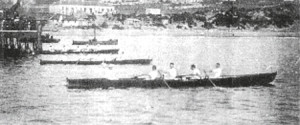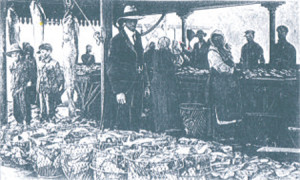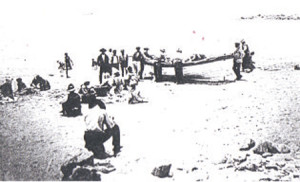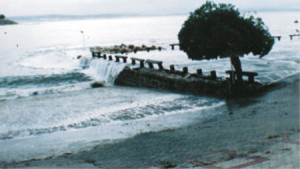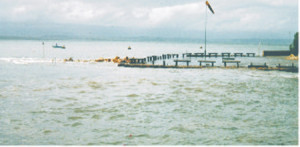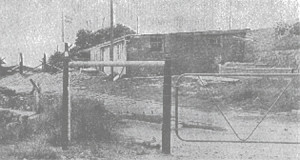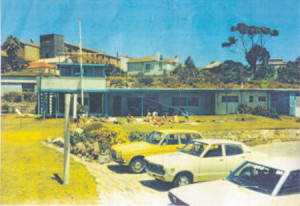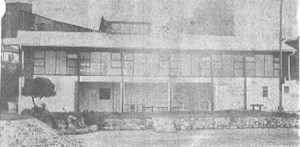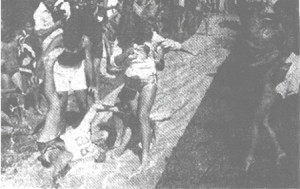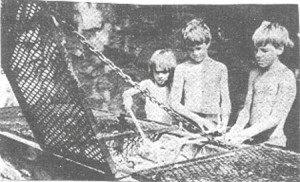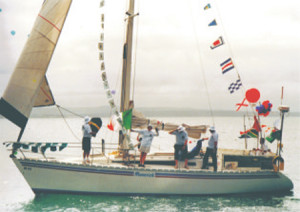A Journey through Time

“The most prominent yachtsman that ever docked his boat in Munro’s Bay was without any doubt, Captain Bartholomew Diaz in the year 1488 AD.
Who could blame him for choosing one of the most beautiful sites along the South Cape coastline, an enclave that was later called Munro’s Bay.”
Dr. Loftus Heunis
Mossel Bay and Munro’s Bay
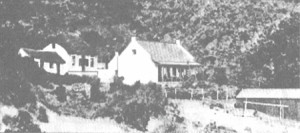 The historian Comely wrote in 1646 that the name “Mossel Bay” was given by Paulus van Caerden in 1601 when he found, besides deer and elephant (!), little refreshment along the coast except “mossels”. Likewise Munro’s Bay, the little beach just east of Santos Beach, was characteristically named after the pioneering Munro fishing family that resided in four cottages (the so called “Munro’s Hoek) just above the high water mark of the Bay. Of course no indication of any yachting shack yet in sight!
The historian Comely wrote in 1646 that the name “Mossel Bay” was given by Paulus van Caerden in 1601 when he found, besides deer and elephant (!), little refreshment along the coast except “mossels”. Likewise Munro’s Bay, the little beach just east of Santos Beach, was characteristically named after the pioneering Munro fishing family that resided in four cottages (the so called “Munro’s Hoek) just above the high water mark of the Bay. Of course no indication of any yachting shack yet in sight!
Early Regattas and Paraphernalia
This little beach attracted a large variety of water sports and in the earlier years, especially regattas (initially with rowing boats) were very popular.
Regattas date back as far as 1877. The earliest full-scale sports event that this research found was one held on the 24th of May, 1881. This Mossel Bay Regatta was won by the boat Mabel of the Pioneer Club. The crew was J. R. Jeffreys, J. Fockens, F. Becker, G. M. Hudson (Stroke) and T. Hill (Cox). The distance covered was 2 miles. The award was a most beautiful, artistically engraved silver dup that is on display in the MBYBC clubhouse.
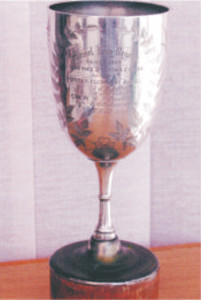 Another important regatta for rowing boats that needs mentioning was one held in 1888. The old Mossel Bay Boating Association organized this “in honor of Her Majesty’s Birthday”. Several events such as the Club Race (with prices worth ₤ 5), and the Club Race for Championship of the Bay (with prizes worth ₤ 7), took place in heavy seas, wind and showers. There was also a very popular and amusing Tub Race as well as a Ladies Price Race. As was the custom, the regatta concluded with a swimming race.
Another important regatta for rowing boats that needs mentioning was one held in 1888. The old Mossel Bay Boating Association organized this “in honor of Her Majesty’s Birthday”. Several events such as the Club Race (with prices worth ₤ 5), and the Club Race for Championship of the Bay (with prizes worth ₤ 7), took place in heavy seas, wind and showers. There was also a very popular and amusing Tub Race as well as a Ladies Price Race. As was the custom, the regatta concluded with a swimming race.
While speaking of trophies, the story about the so-called “koeiklok” (cowbell) needs mentioning. A Mr. Blackwell (Zoutpansberg Boat Club) recalled that one of their members found a silver trophy on a farm in the Louis Trichard (now Mokhado) district with the inscription “Mossel Bay Regatta 1886”, Apparently, it was used as a cowbell!
Fishing
Deep-sea fishing was alive and well in the earlier days and although not for sporting purposes, substantial catches were the order of the day as can be seen on the following photos.
Social events
Social events blossomed during the earlier times and family days such as beach gatherings were quite the order of the day. As can be seen in the photo, beach attire was however quite different from today’s fashionable wear on the beaches of Santos and Munro’s Bay.
The two World wars had a dampening effect on developments worldwide. It is understandable that this was also true of constructive initiative along the Mossel Bay beachfront and it was not until the mid-fifties that the formative stage of the MBYBC commenced.
Melville Stephens and the formative stage of the MBYBC in 1956
In spite of available documentation of this period, it was not an easy task to identify the true founding member of the old Mossel Bay Yacht Club (MBYC) as there are many conflicting opinions in this regard. Research, and especially that done by Rabinowitz (1995: 316), identified Melville Stephens as the most prominent role player in the formative stage of the Club. He proved to be an invaluable source of information on the Club’s past. The additional assitance from Natie Myerson and Dave Elcock via a Voice Activated Recording System is also highly appreciated.
Stephens reflected that when he first came to Mossel Bay in 1954 to restart the then Marine Hotel there were no pleasure boat facilities available. Having aquired a Flying Dutchman class sailing boat, “Condor”, in 1956, he approached the Systems Manager of the Railways to hire the present site of the Club from which to launch his boat. As they could not lease this to a private person, he formed a Club of eight persons in the Marine Hotel bar. This consisted of himself, his barman Tommy Meek, Dan van der Merwe, Mo Taggart, Basil Saayman, an electrician from the Railways, Oven Harris, and a stranger who was passing through. He then submitted these names together with the Table Bay Yacht Club’s constitution only substituting “Table Bay” with “Mossel Bay”. This action brought about the birth of the idea of a “Mossel Bay Yacht Club”.
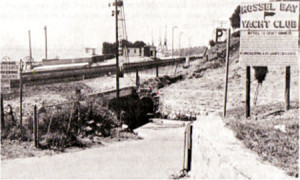 An agreement lease was concluded between the MBYC (Stephens) and the Railways at a cost of ₤ 2.00 per year, which he paid for himself. He then set about breaking ground on the site, also “accidentially” damaging the concrete floor of the storm culvert under the railway line and then repairing it to allow a car and trailer to pass under. The photo shows the early entrance to the MBYBC.
An agreement lease was concluded between the MBYC (Stephens) and the Railways at a cost of ₤ 2.00 per year, which he paid for himself. He then set about breaking ground on the site, also “accidentially” damaging the concrete floor of the storm culvert under the railway line and then repairing it to allow a car and trailer to pass under. The photo shows the early entrance to the MBYBC.
Given all the rocks in the area, it was apparently quite an arduos taks to launch a boat. According to Stephens, he used hotel labour every afternoon to carry out work on the site. He first built a ramp onto Munro’s Bay beach for launching and then constructed a retaining wall between the culvert and the present slipway. When a storm washed the sand out from the launching pad, he started to build a proper slipway.
He then proceeded to build the first structure on the present Club grounds, namely a gear-shed. This shed was on the present site of the manager’s quarters. The garages were at that stage not part of the gear shed, but later constructed when the shed was extended to accommodate a Flying Dutchman with the mast down. Up to this point everything pertaining to his work i. e. labour, cement, shed doors and roofing were paid for by himself. According to Natie Myerson, he did have help in the person of Clifford Harris who was the contractor for the old tank farm.
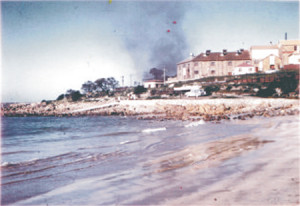 He instructed his supervisor, Albert Hanekom, to build a slipway where the present slipway is located. It was much narrower and shorter and the only instructions given to Hanekom were that it should be that many feet from the gear-shed doors. He was unfortunately not give a gradient in which to lay the slipway and consequently the foot of the slipway barely made the high water mark, which obviously caused many launching problems, especially during low tide. The following photo during a low tide shows that the short slipway did not reach the water level. This certainly indicates the dilemma faced by those attempting to launch.
He instructed his supervisor, Albert Hanekom, to build a slipway where the present slipway is located. It was much narrower and shorter and the only instructions given to Hanekom were that it should be that many feet from the gear-shed doors. He was unfortunately not give a gradient in which to lay the slipway and consequently the foot of the slipway barely made the high water mark, which obviously caused many launching problems, especially during low tide. The following photo during a low tide shows that the short slipway did not reach the water level. This certainly indicates the dilemma faced by those attempting to launch.
On this, Dave Elcock, one of our yachting pioneers remarked that they actually had to carry their boats down the slip and then climb over the rocks at the bottom in order to get to sea.
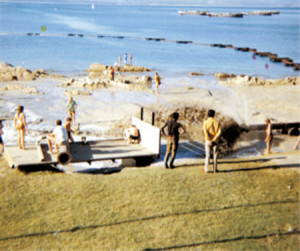 Fortunately, Frank Horler, a shore engineer on site, helped to re-construct the slipway. He added some length to it and altered the gradient towards the foot. Numerous later attempts were made to lengthen the slipway by placing bags filled with concrete in the water and then covering them up with canvas to allow them to settle and cure. This proved not very successful and subsequently a few old petrol drums with the tops cut out were filled with concrete and lowered upside down onto the seabed. By lifting the drum slightly the concrete was shaken out to allow it to disperse and find its way onto the sand bed. This procedure enabled the successful lengthening of the slipway. The following photo shows early construction work on the slipway.
Fortunately, Frank Horler, a shore engineer on site, helped to re-construct the slipway. He added some length to it and altered the gradient towards the foot. Numerous later attempts were made to lengthen the slipway by placing bags filled with concrete in the water and then covering them up with canvas to allow them to settle and cure. This proved not very successful and subsequently a few old petrol drums with the tops cut out were filled with concrete and lowered upside down onto the seabed. By lifting the drum slightly the concrete was shaken out to allow it to disperse and find its way onto the sand bed. This procedure enabled the successful lengthening of the slipway. The following photo shows early construction work on the slipway.
The manager’s office and part of the change room were constructed next to the stone gear shed. The change room was very simple and was situated near the present lapa. Two toilets served by a septic tank were added and were located near the present Club parking area. From here, the effluent was filtered out to the sea. The system worked well for many years until its replacement by a municipal one.
When Dr. Peter Johnston, who normally boated at Little Brak, asked to join, it was time to make the MBYC (called by Stephens “My Bloody Yacht Club”) legitimate.
This initiative was followed by a meeting of boating enthusiasts at the Marine Hotel in Bland Street on Wednesday, September the 24th, 1956, (sources differ with regard to the exact day), where the go-ahead for the formation of a Yacht Club was unanimously approved. Captain N. P. Nell, Marine Assistant, was in the chair until the meeting was properly constituted and he informed the gathering that it was important for the proposed Club to closely co-operate with the Harbor Administration. It was decided from the floor that the newly formed Club would embrace the use of all types of boats from the small sailing boat to the larger yacht.
The Club would be known as the Mossel Bay Yacht Club and Mr. C. H. Shepherd was elected as the first Commodore, Dr. P. Johnston as Vice-Commodore, Mr. A. de Villiers as Rear-Commodore and Mr. M. Stephens as Secretary-Treasurer. The Committee requested Mr. T. Meek to assist them with the drafting of a constitution and get the Club going. It was agreed that membership would be open not only to Mossel Bay, but also to Oudtshoorn, George and Knysna. An official application was made to the Harbor Administration, the first annual general meeting held, and the present day Mossel Bay Yacht and Boat Club took its first steps.
The MBYBC honored Melville Stephens for his dedications and pioneering work, with Life Honorary Membership in 1968.
Interesting Early Recollections
When our Club was in the formative stage in 1955, the Royal Cape Yacht Club celebrated its 50th anniversary at the Arthur’s Seat Hotel in Sea Point.
Our Club’s founder member, Melville Stephens, was the grandson of one Robert Stephens in whose shed the Royal Cape Yacht Club had started in Table Bay a century ago.
In order to promote sailing, dedicated people like Melville Stephens, Natie Myerson, Peter Johnston and others, build “Dabchicks” (apparently a craft like an overgrown surfboard) in the “Blue Room”, the function room of the old Marine Hotel. Their wives supplied the cakes, cookies, coffee and tea.
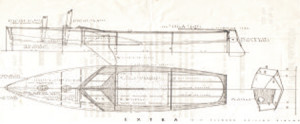 The above-mentioned pioneers in their home-built crafts undertook the first opening cruise of the Club.
The above-mentioned pioneers in their home-built crafts undertook the first opening cruise of the Club.
After graduating from their “Dabchick” phase the men started to build “Extra” type sailing vessels. Melville Stephens obtained the plans of an “Extra” (see plan) and the enthusiastic boys again started to build their new toys!
Early sailing at the Club was a mammoth operation and the sailors had to crouch through the culvert carrying a Flying Dutchman on their heads, as there was no space down to the beach over the rocks. Then the boats were rigged and launched to go sailing only for an hour or two. On returning, this backbreaking process reversed! This was how sailing operated at the MBYBC in the beginning years.
Social Live and House & Grounds
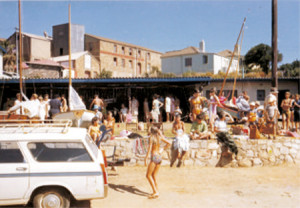 The vision of providing an environment for people with a focus on aquatic sports has always been the aim of the MBYBC. This point of departure was, and still is, the driving force that lies at the root of the continual quest to improve the Club’s grounds and facilities for its members. Looking at the following photo of long ago (1969/1970), one can surely ponder on what significance the Club grounds will have without the people that give it its life and meaning.
The vision of providing an environment for people with a focus on aquatic sports has always been the aim of the MBYBC. This point of departure was, and still is, the driving force that lies at the root of the continual quest to improve the Club’s grounds and facilities for its members. Looking at the following photo of long ago (1969/1970), one can surely ponder on what significance the Club grounds will have without the people that give it its life and meaning.
The parking area: reclaiming of ground
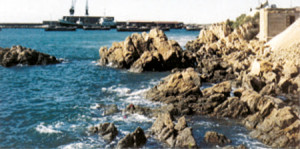 If one looks at old photos of the Club, it is noticeable that the seaward area in front of the Club was very rocky territory.
If one looks at old photos of the Club, it is noticeable that the seaward area in front of the Club was very rocky territory.
It was decided to reclaim it. As can be imagined, the volume of filling needed was enormous. Then somebody hit on a great idea: A dredger annually visited Mossel Bay to dredge the mouth of the harbor, which was very shallow at that time. This could solve the problem. Dave Elcock, a close friend of Melville Stephens, recalls how shallow the whole area was. During low tide, according to him, one could actually walk into the sea in the area below the present Nautilus flats. The idea was that when the dredger again visited Mossel Bay on its annual dredging of the mouth of the harbor, the sand dredged could be pumped into the area that the Club wanted to reclaim.
The dredger hat a massive pump on board and while on anchor in the shallow water just off the slipway it pumped, what was later discovered pure mud into the rocky area. This did the job and a large portion of the parking area was reclaimed. The disadvantage was that the mud, which had been lying on the seabed for many, many years, stank to high heaven! As there was no way to remove it, truckloads of soil had to be imported to cover the mud and keep the stench enclosed on the muddy bottom. The Town Council of that time was well disposed towards the Club and with their assistance and financial help, together with funds from the Club, the area now used for parking was tarred. A retaining wall was obviously required to retain the fill and John Sam who lived in the Round House above Santos Beach constructed this.
A new slipway
In 1971 it was announced that a slipway to accommodate powerboats would be constructed. A donation of R 1000.00 from the Mossel Bay Lions’ Club, other funds raised by the Yacht Club, as well as donations from several individuals made this possible. The residing mayor, Mr. Rudi Barnard, officially opened the slipway on Saturday the 13th of March, 1972. Apparently, this was quite an entertaining spectacle, with members of the Leo Club (young lions) going to sea in and odd assortment of vessels from tin baths to perambulators!
The improvement to the slipway and the provision of a landing quay proved to be a great boon to both yachtsmen and ski-boaters. At the end of the seventies reports had it that the MBYBC was then in possession of the best slipway between the Cape and Port Elizabeth.
… by the way
It appears that the sea was never satisfied with the area reclaimed from it in earlier years and during an unusual high tide in November 1997, it struck back with vengeance, overflowing the whole parking area.
Growth of the ski-boat fraternity
In a speech during the opening cruise in 1978 the then very popular Commodore, Eddie de Swardt mentioned that while ski-boat popularity was increasing, he found it regrettable that sailing was declining as only 10 years previously there had been 20 yachts on the water. He reported that there was now little sailing on the part of its members, but that the Club had been active in selling its waters to the upcountry members.
The Club was originally only a sailing Club. Whit the decrease of yachting, ski-boat angling became a major part of the Club’s boating activities. The Mossel Bay Yacht Club oficially changed its name in 1976 to the Mossel Bay Yacht and Boat Club.
An opening cruise in 1978
As is still customary, the so-called “opening cruise” is the only day during the year when the Club is open to the public to mark the opening of the season. During these earlier years, a large crowd usually attended and enjoyed tea and refreshments, supplied by the energetic ladies of the Club’s Catering Committee.
The Town’s Mayor (then Rudi Barnard) accompanied by the Commodore (at that time, Eddie de Swardt), took the salute at the bypass of numerous craft. Interesting to note is that the still active Romonza (owned by Wim Klapwijk) was present in her full glory accompanied by the NSRI rescue boats Spirit of Rotary, the launch 609, now known as Rescue 15, and the then newly launched cabin cruiser Lilly Marlene.
As was mentioned above, the ladies of the time made a sound contribution to the opening activities. They never hesitated to make their own statements, as was the case with the hostess Peggy Bowles who made beautiful floral arrangements for the ’78 bypass. It consisted of flowers in the orange, blue and white colours of the then South African flag in deference to the newly appointed premier of the time!
A Black Sunday in the Seventies
On Easter Sunday 1970, on a very clear and windless day, during the Finn Olympic trials in which approximately 60 Finn and Extra class boats competed in two different competitions, a rogue Westerly Buster of 50 to 60 knots suddenly hit the Bay capsizing the whole fleet.
This resulted in a very chaotic and dangerous situation. Many lives were in peril as yachtsmen and –women were separated from their boats and strewn all over the Bay. Both Dave Elcock and Natie Myerson recalled this day and Natie, whose boat also capsized, was in the water at the Island for a long period. According to him, he was very fortunate as Louis de Sousa, who was out fishing for bait came to his rescue, took him aboard and towed in his Finn. Along the way, they succeeded in rescuing another person off the Hartenbos River mouth. What worsened the whole situation was that there was no Sea Rescue at that time. Speedboats did most of the rescue work. On returning to the Yacht Club base, Natie took a hot shower, went up to the airfield and pulled out his aircraft to look for other boats that had drifted in the direction of Little Brak River. On spotting a boat, he signalled to Peter Robertson in his speedboat by waggling the wings of his plane. This procedure saved many lives and there were no fatalities.
Commenting on this, Jan Heunis, a senior Club member with years of experience on the water of the Bay, has the firm conviction that the Westerly winds (and especially the sneaky one coming in from the Northern direction), can never be trusted. Against the background of what happened on that Black Sunday, and as will be seen later on in this report also during the National Hobie Competition in 2002, his advice is worth keeping in mind.
On a lighter note
Three points taken from one of the Club’s first Newsletters written in October 1971 by the secretary, V. Saunders are still very valid today, namely:
- Do not let water rob you of a child this summer.
- So you have a cute dog, we will take your word for it; do not bring it to the Club!
- Last season is gone; this season is the first season of the rest of your life.
The Silver Decade
The eighties was the decade when our journey reached its halfway mark, 1981 to be precise. This decade is significant as the Club’s progress can be evaluated both with regard to its first 25 years from 1956 to 1981, as well as with its second phase from 1981 to 2006.
Silver Jubilee Celebration
On October the 30th, 1981, the MBYBC celebrated its 25th birthday with a dinner and dance at the old Santos Hotel. The menu offered hot dishes, a cold buffet and sweets to make the hardiest slimmer weaken! Jean van Waal presented this gourmet fare. Enchanting décor by Liz Ross and the Committee of the Ladies section featured glittering fish mobiles suspended from the ceiling. Pink flowers decorated the tables.
Research indicates that the eighties were an especially active decade in the history of the MBYBC. A week’s program in March / April 1982 is proof of this. How is this for an agenda!
- Saturday, 27: Regatta
- Sunday, 28: Regatta,
- Monday, 29: Saltic,
- Tuesday, 30: Saltic,
- Wednesday, 31: Fish Festival,
- Thursday, 1: Cheese and Wine Evening.
Fish Festival
Apparently, the Fish Festival was a very popular event on the Club’s Agenda and on Easter Saturday the 18th of April 1981, it attracted a crowd of some 300 holidaymakers. The Bay Jazz Combo provided the music. Even the reporter of the Mossel Bay Advertiser (1981.04.22) was quite poetic about the occasion and wrote:
“The scene at the Mossel Bay Yacht Club … was magical! There was a flush of pink in the sky from the sunset, and a huge orange coloured moon rose slowly in the east, making a glittering path on the calm sea. Hundreds of lights from the shore were reflected in the water and the braaivleis fires glowed cosily under the trees”.
New home for the Club
The eighties began with a bang with the residing Commodore, Bill Bowles announcing in January 1980 a proposal for the complete rebuilding of the Clubhouse. At the AGM in 1981, it was announced that the Town Council had agreed to a loan of R40,000.00 at 10% interest over a period of 25 years and that the South African Railways had extended the lease on the grounds to 25 years until 2006. Work started in all earnest and the new Clubhouse opened officially two years later in 1981. The bar officially opened in 1986. Norman Webb was the builder. A flat replaced the gear-shed while the poolroom and garages were added later at the end of the eighties. It was also during these years that the final extension of the slipway was completed. These extensions brought years of hard work and planning to its fulfillment. An article in the Advertiser of Friday the 5th of December 1986, justifies this statement:
“The new extensions of the Clubhouse, with a magnificent bar upstairs and the Gifford’s (then managing couple) delightful flat, as well as the office at ground level have transformed the Yacht Club into premises of which both committee and members can be justly proud. This venue can certainly lay claim to having the most pleasurable ambience in Mossel Bay with its panoramic views and close proximity to the sea”.
The Club arranged finance for the extension project through the Municipality and Brian van der Heuwel was the builder.
The photos show the remarkable transition from the old to the new.
Other improvements that contributed to the Club as it stands today were the upgrading of the balcony by Ivan Westraad (see photo) and the steps that lead up to it which were initiated and sponsored by Natie Myerson.
The present stage
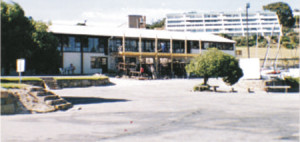 Everyone was impressed with the Club’s new appearance and the sight of this attractive double-storied building received and still receives much favourable comment from members and the public. Visitors to Mossel Bay too have remarked on the appropriate choice of timber and style of architecture, reminiscent of Cape Cod, which blends in so well with its marine surroundings.
Everyone was impressed with the Club’s new appearance and the sight of this attractive double-storied building received and still receives much favourable comment from members and the public. Visitors to Mossel Bay too have remarked on the appropriate choice of timber and style of architecture, reminiscent of Cape Cod, which blends in so well with its marine surroundings.
Twenty years later a visiting French yachtsman made the following remark: “The Club and its surrounding area is truly one of the best kept secrets in the world!”
A bypass with a ducking
The 1980 bypass took place on a clear Sunday afternoon. The great yacht Romonza skippered by her owner, Wim Klapwijk with about 40 people on board drifted slowly past. Half a dozen smaller yachts, two impressive cabin cruisers and five ski-boats followed it. Disaster however struck when L. Ross’ new Spearhead class yacht broke her rudder while turning and keeled over. Ross and his crewmember, Michael Vintcent got a ducking. The NSRI rescue boat, Suiderkaap was right there when it happened and took the two wet sailors to safety.
MBYBC as a family Club
The MBYBC has always been a traditional family Club. The children of Club members were always assured of their place in the sun. It is interesting to note that a family day in 1981 attracted 250 parents and children.
Typical of those social days were the organizing of fun events such as sand castle competitions, tug o’ wars, slip and slide, table tennis, cricket, “suikerkaskenades” and cooking “stokkies-brood”. For the last mentioned cooking activity, a bowl of bread dough was prepared, and when the children came up from the beach games, they enjoyed cooking their own “dampers” on the embers.
The bread dough was rolled around the end of long sticks. Then the children held the sticks and dough over the hot ashes. When the bread was cooked, the sticks were removed and the hollows filled with golden syrup. Happiness had sticky fingers and a beaming face!
Happy children having fun at a family day, and on the next photo doing their own “stokkiesbraai”.
The Club’s ladies
On entering the premises of the Club, you become aware of them. They clean the grounds, smile at you in the office, serve you in the bar and the restaurant, adorn the green grass area on their colourful towels, run after the little ones, help with the launch of sea going craft, sail, angle, dive and organize. They even appear as names on boats, their touch is evident when sharing a lunch box and coffee with a mate out in the blue, they are there with a cold beer for their man coming back after a morning out, they vote at AGM’s and applaud at prize-givings. They are:
- everywhere
- the heartbeat of the Club, and
- a home base for their men or friends at sea.
The active involvement of the ladies of the Club weaves like a golden thread through the history of the MBYBC. They were in earlier years the ones who:
- catered for regatta lunches
- served tea and cakes during Sunday afternoon functions
- sold cakes outside Woolworths on Saturday mornings to raise funds for the Club, and
- sewed the sails for the boats that the men built.
The ladies were never shy as far as the quantity and quality of refreshments presented were concerned. A good example of this was an Oyster Feast at the Club during a time when oysters were plentiful and were available at 10 shillings for half a sugar pocket. One of the visiting gentleman from the Worcester Club, got totally carried away with the feast of food and oysters laid out before him, over indulged himself, got horribly sick and fell asleep on the little bit of grass outside the Club until the rising sun awoke him the next morning.
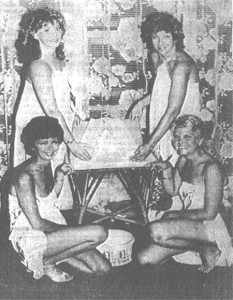 While on the topic of festivities, mention can be made of the “King Carnival”. This event was quite an occasion and organized to raise funds for the building fund of the Club. In the true spirit of carnival, people were invited to arrive in fancy dress. There was a band, dancing, games arranged for the children, a feast of international foods such as a fish braai, Greek, Japanese, Hawaiian, French and American dishes, exotic Indian curries and a Dutch Soup Kitchen with a bar. Compared to current prices, costs were low and the entrance fee only R1.00. The Carnival of December the 27th 1981 raised the amount of R1003.00.
While on the topic of festivities, mention can be made of the “King Carnival”. This event was quite an occasion and organized to raise funds for the building fund of the Club. In the true spirit of carnival, people were invited to arrive in fancy dress. There was a band, dancing, games arranged for the children, a feast of international foods such as a fish braai, Greek, Japanese, Hawaiian, French and American dishes, exotic Indian curries and a Dutch Soup Kitchen with a bar. Compared to current prices, costs were low and the entrance fee only R1.00. The Carnival of December the 27th 1981 raised the amount of R1003.00.
By the way, the ladies of times past were not only dedicated and efficient, they were reputed to be just as beautiful in those years as the female fraternity of today. Let there be no doubt that they would have given the current Me. MBYBC a good run for her money. Seen on the photo taken during the annual Aquarius party in 1984 are Conti Muir and Claire Groenink (in front) and Jenny Asher and Ena Thackray at the back.
The Yacht Club Recipe Book
The ladies of the 1981 Ladies Committee compiled an excellent recipe book to raise funds for the Club and the NSRI. This publication of 154 pages took four months of after hour work to compile. At a modest R5.50, the book was a bargain and with the support of local business, it apparently sold like the proverbial hot cake. In the letter that accompanied the book’s distribution, Reneè Leach wrote that:
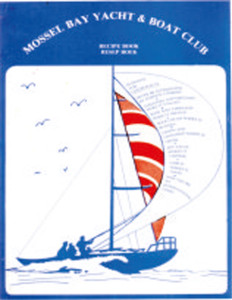 ”… a local businessman and member, has bought 20 copies and reserved 20 more which he intends giving to special clients “.
”… a local businessman and member, has bought 20 copies and reserved 20 more which he intends giving to special clients “.
The recipe book received wide acclaim. The comment of a Sunday Times acknowledged culinary expert of the time, Ann Wise, was that:
“… she liked the book altogether because the recipes are practical, sensible and easy to follow, yet with enough panache to tempt one to try something new”.
One can not but agree with this statement when looking at some of the mouth-watering dishes such as cold sea cat with mayonnaise, Kingklip cooked in champagne and Tuna prepared in a slow casserole.
Good news!
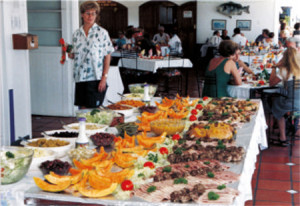 The “revival” of the Recipe Book is under consideration and will be announced in the Club’s Newsletter. When it becomes available, do not miss out: – Buy it and try it! –
The “revival” of the Recipe Book is under consideration and will be announced in the Club’s Newsletter. When it becomes available, do not miss out: – Buy it and try it! –
Their worthy predecessors never overshadowed the ladies of later years and the feast on the following photo was Christmas lunch in December 1997.
With reference again to the opening paragraph of this entry, it can be concluded that the ladies of the Club are a special breed of women and we appreciate them.
A Christmas Story
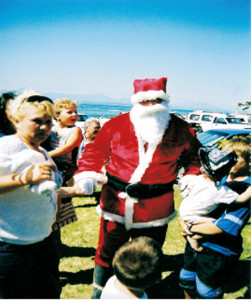 The Club invites Father Christmas around every year. As can be expected, the children always welcome him with great enthusiasm.
The Club invites Father Christmas around every year. As can be expected, the children always welcome him with great enthusiasm.
One year, not long ago, a comic drama unfolded during a visit from an MBYBC Father Christmas (the name of the specific father shall remain anonymous). On the day in question, all dressed in red, with white beard and hat, he arrived on an NSRI boat, bellowing the “A-hoi! A-hoi”. As the boat was mooring, he stood on the gun whale and took hold of the jetty. This of course was a fatal mistake, because a surge started to move the boat away from the jetty leaving the honourable Father Xmas stretched in a very awkward horizontal position. All he could do was to look up, groan a last “A-hoi—– !”, and then to the horror of the kids, and the hilarious delight of the grown-ups, drop face down into the churning waters of the slipway! Shows you mates, seawater and alcohol are not a good mix!
They were naughty too!
The New Year’s Eve dance was an important item on the early Club’s agenda. One such occasion was organized in a make-shift tent, but because of a storm it turned out to be a total disaster. The dance was called off, but everybody being in the right mood, it was decided that a skinny dip in Munro’s Bay was an ideal alternative, men on the one side and the ladies on the other side. Great fun was enjoyed but unfortunately, one of the ladies, known as “Black Val”, because of the colour of her hair, lost an important piece of underwear and was rather embarrassed. She had to go back to the Club wearing a dress over slacks without the important piece of clothing!
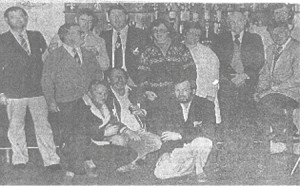 It might be interesting to highlight certain aspects of the Club after its first 25 years.
It might be interesting to highlight certain aspects of the Club after its first 25 years.
The committee at the time can be seen in the photo below, from left to right: Fanie Leach (Commodore), Jan Swanepoel (Vice- Commodore: Sailing), Butch van der Westhuizen (additional member), Kallie van Aswegen (Vice-Commodore: Boating), René Leach (additional member), Pam Templeton (Secretary/Treasurer), Eddie de Swardt (President), Ian Hamilton (additional member) and Rayner van Niekerk (additional member). Kneeling are, Ray Templeton (additional member), Billy Brooks (Rear-Commodore) and Bill Ross (additional member).
The Club Commodore, Fanie Leach, reported a membership of 333 members “… with a few in the pipeline”.
Opening cruises
The following photos show scenes typical of the Club’s annual opening cruise.
Membership fees
Whereas members had previously paid only R20.00, the subscription fee per year per family doubled to R40.00. This was the only method by which to gather the required R4000.00 per annum to pay off the loan of R40 000.00 from the Town Council for the tarring of the parking area. Good news for the pensioners was that they would only pay R20.00!

